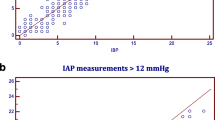Abstract.
Objective: Intra-abdominal pressure (IAP) can be measured in different ways but is usually measured indirectly via the urinary bladder. The aim of the study was to: 1) compare urinary bladder pressure, femoral vein pressure, and inferior caval vein pressure with IAP at different levels of IAP; and 2) try to find an optimal amount of fluid to be instilled into the urinary bladder before measurement of the bladder pressure, and to compare changes in blood flow in the femoral vein with that in the caval vein at different pressure levels. Design: Experimental study. Setting: Animal research laboratory. Subjects: Eight domestic swine of both sexes, weighing 30.6±2.9 kg (mean±SD). Interventions: Catheters connected to pressure transducers were placed into the urinary bladder, the inferior caval vein, the femoral vein, and the superior caval vein. Transit time flow probes were placed around the inferior caval vein and the femoral vein. After a stabilizing period, the abdominal pressure was increased stepwise by instillation of Ringer's solution into the abdomen and then decreased. Thereafter, we instilled fluid into the bladder at an IAP of 8 mmHg and at 20 mmHg and measured the amount of fluid needed to elevate the intra-vesical pressure by 2 mmHg. Results: The pressures recorded in the urinary bladder, the inferior caval vein, and the femoral vein reflected the pressure in the abdominal cavity very well. The fluid volume needed to increase the bladder pressure by 2 mmHg was significantly lower at 20 mmHg IAP than at 8 mmHg. Blood flow in the femoral vein and the inferior caval vein showed a similar pattern and decreased when the intra-abdominal pressure increased. Conclusions: In our porcine model, and increasing the IAP by means of instillation of Ringer's solution, a reliable estimation of the IAP was obtained by measuring the pressure in the urinary bladder, the femoral vein or the inferior caval vein. The IAP estimated indirectly as the urinary bladder pressure is affected by the amount of fluid in the bladder, which should not exceed 10–15 ml. The decrease in femoral vein blood flow reflects the changes in inferior caval vein flow during increased IAP.
Similar content being viewed by others
Author information
Authors and Affiliations
Additional information
Electronic Publication
Rights and permissions
About this article
Cite this article
Gudmundsson, F., Viste, A., Gislason, H. et al. Comparison of different methods for measuring intra-abdominal pressure. Intensive Care Med 28, 509–514 (2002). https://doi.org/10.1007/s00134-001-1187-0
Received:
Accepted:
Published:
Issue Date:
DOI: https://doi.org/10.1007/s00134-001-1187-0




